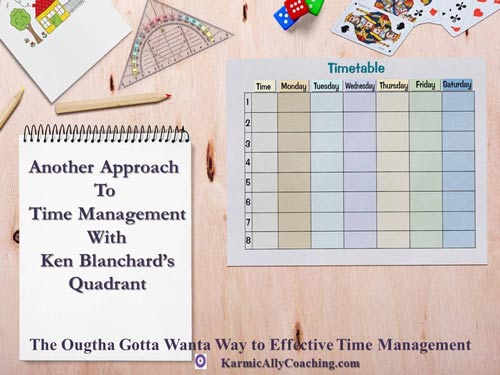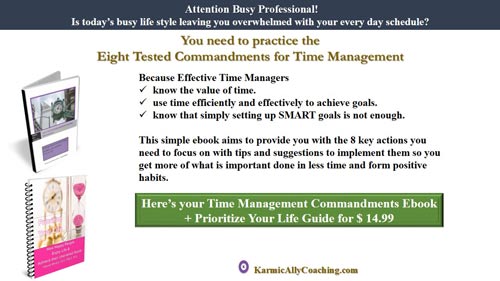
Have I discovered a new method for effective Time Management?
Wrong!
It’s just that Covey’s Quadrants have been stated over and over again and from experience, I know that if I look at a thing too many times, I start missing details.
I started to think, how I could inspire myself, my clients and readers to get their time under control.
So, I went hunting in my Treasure Chest of tools and techniques. I found two old beauties that I use.
They are quite handy in the run up to Diwali when there is housecleaning, gift buying and a whole lot of other things start to appear Urgent and Important as Diwali approaches and Clarity goes out of the window.
In fact, this tool works whenever one feels there are too many tasks and overwhelm is setting in.
Before I share the two methods, I must clarify, there is no ‘Oughta Gotta Wanta’ Way to Effective Time Management.
It’s just a phrase my Dad used to say to tease me and my sister when we’d procrastinate, knowing full well that we had to do a task, be it homework or helping in the house.
Since everyone worth their salt has read Covey’s The 7 Habits of Highly Effective People in some form or the other, let us stick to the quadrant approach but look at it from another perspective.
Another Approach to Time Management with Ken Blanchard’s Quadrants

Ken Blanchard – the author of the popular book The One Minute Manager and The On-Time, On-Target Manager – also devised a quadrants approach:
Quadrant 1 – Have to Do, Want to Do
Quadrant 2 – Have to Do, Don’t Want to Do
Quadrant 3 – Don’t Have to Do, Want to Do
Quadrant 4 -Don’t Have to Do, Don’t Want to Do
As expected, most of us won’t have a problem with Quadrants 1 and 4.
When there is no conflict of interest, all is well.
The fun starts with Quadrants 2 and 3– boss tells us we have to work on the weekend to meet a deadline when we would rather go to the mall or supermarket and shop is a good example of Quadrant 2.
Now if the need to go shopping on a weekend is important enough, say you need to replace the hoover in the house or need to pick up the groceries, then explaining your situation to the boss might help to reach a compromise. You could come in after lunch and then stay till the work gets done.
You might save money because you know you have to go into work later. You’ll spend less time window shopping and picking up stuff you don’t need but it is on sale. I call it balance and collateral financial benefits.
For some reason, most of us are likely to be attracted to Quadrant 3, meaning things that do not have to be done but we get them done. Does that ring a bell?
The advice offered by Blanchard for managers, and which applies in any situation is to take up tasks in the order of Quadrant 2 and Quadrant 1 and spend little or no time on Quadrant 3 items (Wasted Time Tasks).
A good approach would be to first create a To Do List and thereafter plan accordingly. You might just find some things disappear from the list without even doing anything. Hurrah!
But what happens if clarity does fly out of the window. Or you KNOW you need to get different tasks done but cannot decide on the order?
I’ll tell you more about it in my next post but for the time being practice the Blanchard Quadrants method. See if it works better for you.
In the meantime, to spare anyone and everyone who may have time management concerns I have 2 suggestions. Both will break old archaic non-benefiting habits and replace them with ones that have value. There are solutions.
The first is my short but effective online course created as a 5 Step Method to win your Time Management Challenge.
The second one is something from personal experience.
I’ve discovered eight self- tested commandments on time management . It works like a dream to develop long term prioritization and time management habits.
I’d posted these commandments a few years back on my Facebook Fan Page which many people found useful -or at least pressed the ‘Like’ Button
Now this is something you Oughta Gotta Wanta have!
Updated for relevance.





 I adhere to the Certified Coaches Alliance Code of Ethics and Standards. A copy is available on request.
I adhere to the Certified Coaches Alliance Code of Ethics and Standards. A copy is available on request.
 Let's Talk through the Connect Form:
Let's Talk through the Connect Form: